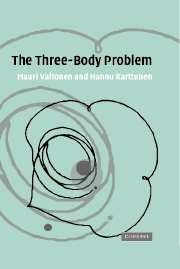Book contents
- Frontmatter
- Contents
- Preface
- 1 Astrophysics and the three-body problem
- 2 Newtonian mechanics
- 3 The two-body problem
- 4 Hamiltonian mechanics
- 5 The planar restricted circular three-body problem and other special cases
- 6 Three-body scattering
- 7 Escape in the general three-body problem
- 8 Scattering and capture in the general problem
- 9 Perturbations in hierarchical systems
- 10 Perturbations in strong three-body encounters
- 11 Some astrophysical problems
- References
- Author index
- Subject index
5 - The planar restricted circular three-body problem and other special cases
Published online by Cambridge University Press: 04 December 2009
- Frontmatter
- Contents
- Preface
- 1 Astrophysics and the three-body problem
- 2 Newtonian mechanics
- 3 The two-body problem
- 4 Hamiltonian mechanics
- 5 The planar restricted circular three-body problem and other special cases
- 6 Three-body scattering
- 7 Escape in the general three-body problem
- 8 Scattering and capture in the general problem
- 9 Perturbations in hierarchical systems
- 10 Perturbations in strong three-body encounters
- 11 Some astrophysical problems
- References
- Author index
- Subject index
Summary
After the two-body problem, the next more complicated system consists of three bodies. Let us call these bodies the Sun, planet and asteroid. Some further assumptions are made to keep the system as simple as possible. The word restricted means here that the mass of the asteroid is so small that it does not significantly affect the motion of the primaries (the Sun and the planet). The primaries move in circular orbits, and the asteroid is assumed to move in the same plane as the primaries. The perturbations due to the third body can be neglected and the positions of the primaries can be calculated analytically for all times. The problem is now to find the trajectory of the massless body.
The assumption about the mass of the asteroid is a little problematic. If the primaries affect the motion of the asteroid, it must, of course, affect their motions according to Newton's third law. The accuracy required determines whether the third body can actually be considered massless. Discarding Newton's third law has a side effect: total energy is no longer conserved. However, the energy conservation law can be replaced by another similar law.
Coordinate frames
When studying the restricted circular three body problem, the units are usually chosen in such a way that the properties of the system depend on a single parameter.
- Type
- Chapter
- Information
- The Three-Body Problem , pp. 115 - 140Publisher: Cambridge University PressPrint publication year: 2006



